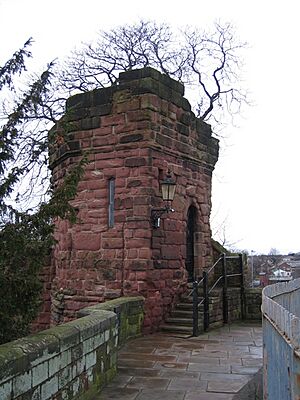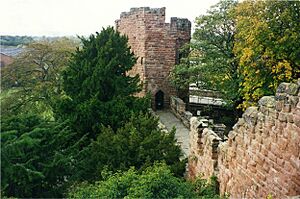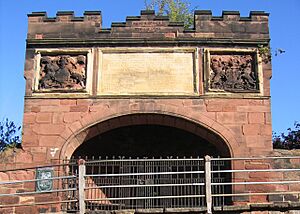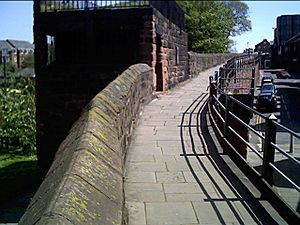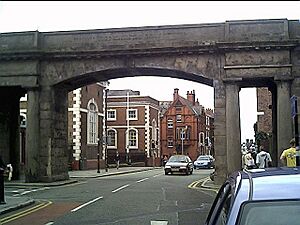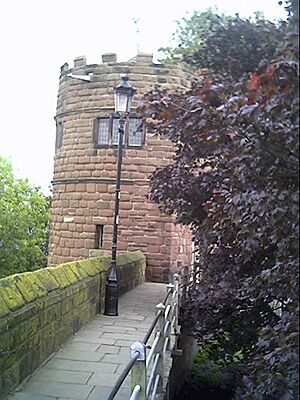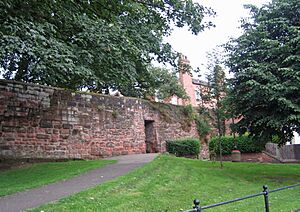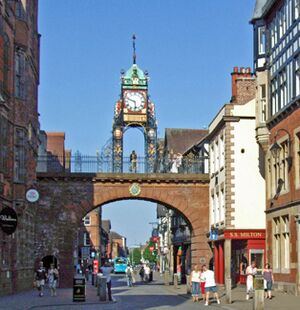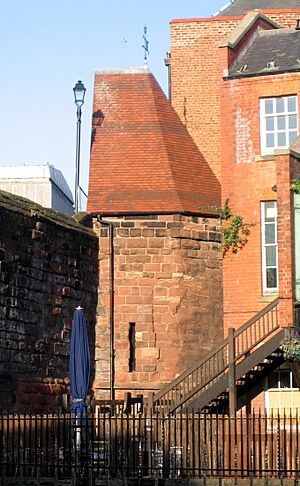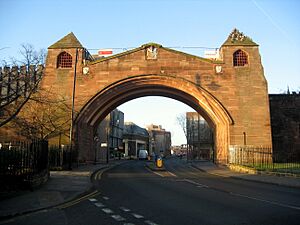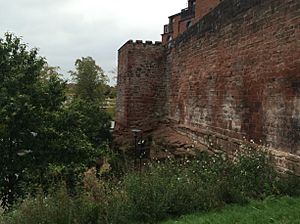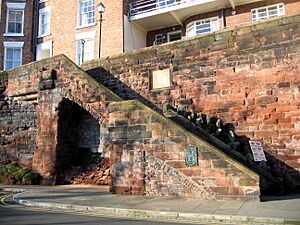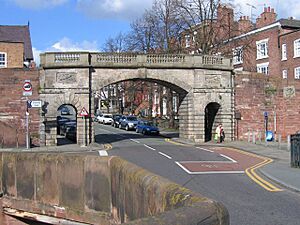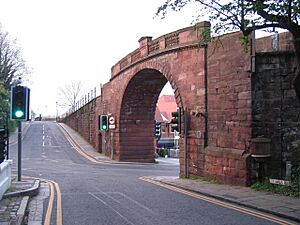List of sections of Chester city walls and associated structures facts for kids
The Chester city walls are amazing ancient walls that surround the city of Chester in England. They are super old, starting way back when the Romans were in Britain! These walls began as a way to protect the Roman fort called Deva Victrix around 70 to 90 AD. Back then, they were made of earth with wooden fences on top, and had wooden gates and towers.
Later, a Roman army group called the Legio XX Valeria Victrix arrived. They rebuilt the walls using strong sandstone, and it took over 100 years to finish the Roman part of the walls. They also rebuilt the towers and gates in stone. Even after the Romans left, the walls were still important. In 907, a powerful leader named Æthelflæd made Chester stronger again, likely using parts of the old Roman walls.
The walls you see today were mostly finished by the end of the 1100s. The northern and eastern Roman walls were used, and new sections were built to the west and south, reaching the River Dee. Back then, people thought the river was enough protection on the west and south sides, so only the north and east walls had towers. Keeping the walls in good shape was a constant job! Sometimes, old Roman altars and tombstones were even used as building materials for repairs. You can see some of these old tombstones in the Grosvenor Museum today.
During the English Civil War in the 1640s, the walls and their towers were damaged, especially when the city was under attack. After the war, more repairs were done, but it was always a big challenge to fix everything.
By the 1700s, the walls weren't needed for defense anymore. Instead, they became a popular place for people to walk and enjoy the views! In 1707, the city spent a lot of money (about £1,000, which would be a huge amount today!) to fix the walls and pave the walkway. Famous visitors like John Wesley and Samuel Johnson enjoyed walking on them. The four main gates were replaced with new ones in the 1700s and early 1800s. Later, in 1846, the walls were even cut through to make way for the Chester and Holyhead Railway. More recently, Newgate was opened in 1938 for a new road, and St Martin's Gate was built in 1966 to cross the Inner Ring Road.
Today, the "walls, tower, gates and posterns of the City of Chester" are a special scheduled monument. This means they are protected because of their historical importance. Most of the towers and walls are listed as Grade I buildings, which means they are incredibly important and interesting.
The entire path along the walls is about 2 miles (3 km) long and can reach a height of 40 feet (12.2 m). It's known as the most complete set of Roman and medieval defensive town walls in Britain! Walking along them is a real delight for visitors. The wall walk starts in the northwest corner at Bonewaldesthorne's Tower and goes clockwise around the city.
Contents
Exploring Chester's Historic Walls and Gates
Chester's city walls are dotted with fascinating towers and gates, each with its own story. Here are some of the most interesting ones you can see as you walk along the wall.
North Wall Highlights
The north wall has some of the oldest parts and interesting features.
Bonewaldesthorne's Tower and Water Tower
At the northwest corner of the walls, you'll find Bonewaldesthorne's Tower. It was first mentioned in 1249. Later, it became the entrance to the Water Tower. The Water Tower was built between 1322 and 1325. Back then, it actually stood in the River Dee! But over time, the river filled with silt, and now the tower is about 200 yards (183 m) inland. Both towers were used as a museum in the 1800s and early 1900s.
Pemberton's Parlour
This spot was originally a round tower. In the 1700s, it was changed into a half-circle shape. It's named after a former mayor of Chester, Mr. Pemberton, who supposedly watched work on his nearby rope-making business from here.
Morgan's Mount
Built in 1645 during the English Civil War, Morgan's Mount was a lookout point and a place to put cannons. It's a rectangular building with a room at the same level as the wall walk. Steps lead up to a platform where soldiers could watch for enemies.
Northgate
Northgate stands where the Roman fort's northern entrance used to be. The current gate was designed by Thomas Harrison and built in the early 1800s. It has a large arch for the road and smaller arches on the sides for people walking.
Phoenix Tower
Phoenix Tower was used by two of Chester's old guilds (groups of skilled workers) from the 1500s to the 1700s. The mythical bird, the phoenix, was the symbol of one of these guilds, and you can see it carved on a plaque on the tower. This tower was also damaged during the English Civil War. Today, it's a popular spot for tourists.
East Wall Features
The east wall also has parts from Roman times and important gates.
Kaleyard Gate
Kaleyard Gate is a smaller, secondary gate in the walls. It was built in the 1200s after the monks of St Werburgh's Abbey asked King Edward I for a direct way to their vegetable garden (or "kaleyard").
Eastgate
Eastgate was built in 1768, replacing older gates at the original eastern entrance to the Roman city. The famous wrought iron clock tower was added in 1899 to celebrate Queen Victoria's 60th year as queen. The clock itself was made by a company in Whitchurch, Shropshire.
Thimbleby's Tower
Thimbleby's Tower was once a round tower, but it was partly destroyed during the siege of Chester in the Civil War. When the wall walk was created in the 1700s, it was changed to fit in. In the 1990s, a new roof was added.
Newgate
Newgate was built in 1938 to help with traffic in the city center. It's a bridge that carries the wall walk over the new road, with steps leading up to it.
South Wall and River Views
The south wall offers great views of the River Dee.
Barnaby's Tower
Dating from the 1200s, Barnaby's Tower was also damaged in the English Civil War. When the wall walk was made, it was changed to be level with the path. It's decorated with fake castle-like battlements.
Recorder's Steps
The Recorder's Steps are two sets of stairs that lead down from the wall walk to an area called the Groves, next to the river. They were built in 1720.
Bridgegate
Bridgegate was built in 1781-82 and replaced an older gatehouse. It's designed in a classical style with a central arch for the road and smaller arches for pedestrians. Just south of it, the Old Dee Bridge crosses the River Dee.
West Wall and Racecourse Views
The west wall overlooks the famous Chester Racecourse.
Watergate
Watergate was built between 1788 and 1790, replacing a medieval gate. It has a wide arch and a stone railing along the top. You can also find a drinking fountain from 1857 attached to it.
Images for kids


